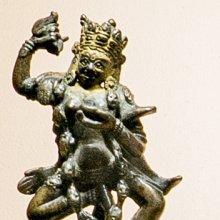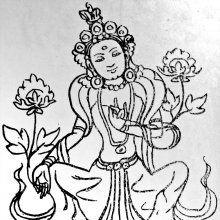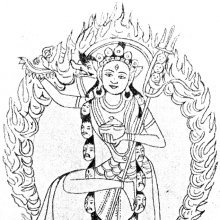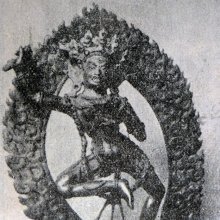Vashya, Vaśya, Vāsya: 24 definitions
Introduction:
Vashya means something in Buddhism, Pali, Hinduism, Sanskrit, Marathi, Hindi. If you want to know the exact meaning, history, etymology or English translation of this term then check out the descriptions on this page. Add your comment or reference to a book if you want to contribute to this summary article.
The Sanskrit term Vaśya can be transliterated into English as Vasya or Vashya, using the IAST transliteration scheme (?).
Alternative spellings of this word include Vashy.
Images (photo gallery)
In Hinduism
Shaivism (Shaiva philosophy)
Source: Wisdom Library: Kakṣapuṭa-tantraVaśya (वश्य) refers to “controlling others”. It is a siddhi (‘supernatural power’) described in chapter one of the Kakṣapuṭatantra (a manual of Tantric practice from the tenth century).
Source: Shodhganga: Mantra-sādhana: Chapter One of the Kakṣapuṭatantra1) Vaśya (वश्य) refers to “controlling others” and is accomplished by performing mantrasādhana (preparatory procedures) beginning with japamālā using a rosary bead made of ruby, according to the Kakṣapuṭatantra verse 1.44. Accordingly, “it is said that a rosary made of coral beads is for the sārasvatī (acquiring eloquence); the same rosary or a rosary made of ruby is for vaśya (controlling others); and a rosary of putrajīva is for all kinds of ritual”.
2) Vaśya (वश्य, “controlling”) or Vaśī refers to one of the “seven means” (saptopāya) to be performed when a mantra does not manifest its effect, as explained in the 10th-century Kakṣapuṭatantra verse 1.98-100. Vaśya brings the mantra under his control. One should write the mantra with red sandalwood, costus, turmeric, beeswax, and red arsenic on a birch bark, and wear it around oneʼs neck. If this does not work, the pīḍana comes next.
Accordingly, “being awoken in this way, it will have an effect. If not, one should carry out the vaśī (controlling). Having written the mantra with the ārakta-candana (red sandalwood), kuṣṭha (costus), haridrā (turmeric), madana (beeswax), and śilā (red arsenic) on a beautiful leaf of birch bark, one should wear it around his neck. [Then] the mantra will have an effect. [It is called vaśya.] [If the controlled mantra does not have an effect], one should perform the pīḍana (pressing)”.
Note on kuṣṭha: the Śrīvidyārṇavatantra (Chapter 16 p.378) support dāru (Deodar). Note on śilā: the Tattvacintāmaṇi (20.99) support sihla (olibanum).

Shaiva (शैव, śaiva) or Shaivism (śaivism) represents a tradition of Hinduism worshiping Shiva as the supreme being. Closely related to Shaktism, Shaiva literature includes a range of scriptures, including Tantras, while the root of this tradition may be traced back to the ancient Vedas.
Shaktism (Shakta philosophy)
Source: Google Books: ManthanabhairavatantramVaśya (वश्य) or Vaśyāveśa refers to “controlled possession” and represents the particular sign associated with the Fourth Praṇava, according to the Manthānabhairavatantra, a vast sprawling work that belongs to a corpus of Tantric texts concerned with the worship of the goddess Kubjikā.—The “Sūtra of the Five Praṇavas”, which is chapter fifty-four of the Kumārikākhaṇḍa, is concerned solely with aligning the praṇavas with the seats and placing them along the axis of the body. According to this sūtra, each of the Five Praṇavas has its own colour and corresponds to a state of attainment evidenced by signs of possession (āveśa) [i.e., vaśya-āveśa, ‘controlled possession’]. They are projected into five places along the vertical axis of the body, which, in some cases, correspond to the locations of the inner Wheels implying thereby that they mark stages in the ascent of Kuṇḍalinī through them. [...]
Source: Google books: Genesis and Development of Tantra (Shaktism)Vaśyā (वश्या) refers to “subjugating people to one’s will” and represents one of the various Siddhis (“supernatural powers”) according to the Siddhayogeśvarīmata: an ancient Sanskrit text devoted to cults of Goddesses as the Vidyāpīṭha or Vidyā Corpus.—Although Vedic rituals were a reliable way for the people of ancient India to fulfill their objectives, Tantric rites too claim to bring about the attainment of wishes. [...] In the Siddhayogeśvarīmata, the objectives of the rites are classified as siddhis [e.g., subjugating people to one’s will (vaśyā)]. They belong to the category of supernatural phenomena and seem to be considerably different from the types of wish people expected to gain from the Vedic rituals that still remained within the sphere of everyday life.

Shakta (शाक्त, śākta) or Shaktism (śāktism) represents a tradition of Hinduism where the Goddess (Devi) is revered and worshipped. Shakta literature includes a range of scriptures, including various Agamas and Tantras, although its roots may be traced back to the Vedas.
Purana and Itihasa (epic history)
Source: archive.org: Shiva Purana - English TranslationVaśya (वश्य) means “under control” (i.e., one who is under the control of another), according to the Śivapurāṇa 2.3.11.—Accordingly, as Himavat (Himālaya) eulogised Śiva: “[...] O great lord, your divine sports are incomprehensible. They bestow happiness on saintly men. Your nature is subservient to the devotees and you are under their control [i.e., bhakta-vaśya]. You are the performer of all activities. O lord, you have come here because my fortune is in its ascendancy. You have been described as a bestower of favours to the distressed. You have put me under your patronage and protection. [...]”.

The Purana (पुराण, purāṇas) refers to Sanskrit literature preserving ancient India’s vast cultural history, including historical legends, religious ceremonies, various arts and sciences. The eighteen mahapuranas total over 400,000 shlokas (metrical couplets) and date to at least several centuries BCE.
Pancaratra (worship of Nārāyaṇa)
Source: University of Vienna: Sudarśana's Worship at the Royal Court According to the AhirbudhnyasaṃhitāVaśya (वश्य) refers to “conquering (the world)”, according to the Ahirbudhnyasaṃhitā, belonging to the Pāñcarātra tradition which deals with theology, rituals, iconography, narrative mythology and others.—Accordingly, “He who has the Yantra of Narasiṃha joined with [that] of Sudarśana constructed shall conquer even the other world (loka-vaśya—loko vaśyo bhaved api). Just by drawing this, men can attain everything”.

Pancaratra (पाञ्चरात्र, pāñcarātra) represents a tradition of Hinduism where Narayana is revered and worshipped. Closeley related to Vaishnavism, the Pancaratra literature includes various Agamas and tantras incorporating many Vaishnava philosophies.
Yoga (school of philosophy)
Source: ORA: Amanaska (king of all yogas): A Critical Edition and Annotated Translation by Jason BirchVaśya (वश्य) refers to the “subjugation (of the world)”, according to the Amanaska Yoga treatise dealing with meditation, absorption, yogic powers and liberation.—Accordingly, as Īśvara says to Vāmadeva: “[...] [Now], I shall define the nature of that highest, mind-free absorption which arises for those devoted to constant practice. [...] [The yogin] whose absorption in the steady self remains for twenty-eight days, obtains the Siddhi of control, by which he subjugates the world (vaśya-kṛt) [vaśyakṛjjagat]. [...]”.

Yoga is originally considered a branch of Hindu philosophy (astika), but both ancient and modern Yoga combine the physical, mental and spiritual. Yoga teaches various physical techniques also known as āsanas (postures), used for various purposes (eg., meditation, contemplation, relaxation).
Mantrashastra (the science of Mantras)
Source: Wisdom Library: MantrashastraVaśya (वश्य, “control”) refers to one of the seven techniques to improve or revive fruitless mantras (i.e., “mantras that do not bring satisfaction and visible improvements”), according to the Kakṣapuṭatantra verses 1.89.91.—The operation of vaśya (control) is described as: One should write a mantra from red sandalwood powder, costus plant, turmeric, beeswax and red arsenic on birch bark and wear it around the neck. If this doesn't work, then commit to Pīḍana (pressure).
Source: Shodhganga: Kasyapa Samhita—Text on Visha Chikitsa (mantra)Vaśya (वश्य, “subjugation”) refers to one of the eight divisions of the object or purpose of a Mantra, according to the Śrīpraśṇa-saṃhitā (verse 50.70-2).—Mantras refers to “that which is chanted by people to obtain their spiritual aspirations”.
Mantrashastra (शिल्पशास्त्र, mantraśāstra) refers to the ancient Indian science of mantras—chants, incantations, spells, magical hymns, etc. Mantra Sastra literature includes many ancient books dealing with the methods reciting mantras, identifying and purifying its defects and the science behind uttering or chanting syllables.
Ayurveda (science of life)
Source: archive.org: Catalogue of Pancaratra Agama Texts (ay)Vaśya (वश्य) refers to one of the six aims for which the Garuḍamantra may be employed, according to the second chapter of the Kāśyapasaṃhita: a Pāñcarātra Āgama text composed of 13 chapters dealing with snake-bites, poisons and curing their venom by use of the garuḍamantra while also dealing with worship and devotion. Description of the chapter [viniyoga-vidhi]:—Returning to the mantra, Gautama asks to know how it may be employed for special viniyoga-purposes. Kaśyapa says that there are six aims for which this mantra may gainfully be employed: śāntika, pauṣṭika, rakṣāvidhi, vaśya, ākarṣaṇa and kṣudravidhi (1-3). The peculiar, variant practices to be employed in each case are given—for the most part, entailing the use of different kinds or quantities of offerings in the required homas (4-40). [...]

Āyurveda (आयुर्वेद, ayurveda) is a branch of Indian science dealing with medicine, herbalism, taxology, anatomy, surgery, alchemy and related topics. Traditional practice of Āyurveda in ancient India dates back to at least the first millenium BC. Literature is commonly written in Sanskrit using various poetic metres.
In Buddhism
Mahayana (major branch of Buddhism)
Source: De Gruyter: A Buddhist Ritual Manual on AgricultureVaśya (वश्य) refers to “(being) subdued” (as part of an offering ritual), according to the Vajratuṇḍasamayakalparāja, an ancient Buddhist ritual manual on agriculture from the 5th-century (or earlier), containing various instructions for the Sangha to provide agriculture-related services to laypeople including rain-making, weather control and crop protection.—Accordingly, [as the Bhagavān teaches the offering of the root spell], “[...] When 1,008 recitations have been made, all great Nāga kings are subdued (vaśya). They will always appear. They will always provide all that is wished for. They accomplish everything in detail. All retinues of kinsmen with children and grandchildren are subdued. They do everything that is desired. They guard him as if it were their own home”.

Mahayana (महायान, mahāyāna) is a major branch of Buddhism focusing on the path of a Bodhisattva (spiritual aspirants/ enlightened beings). Extant literature is vast and primarely composed in the Sanskrit language. There are many sūtras of which some of the earliest are the various Prajñāpāramitā sūtras.
Languages of India and abroad
Marathi-English dictionary
Source: DDSA: The Molesworth Marathi and English Dictionaryvaśya (वश्य).—n (S) Amity or agreement of the horoscopes &c. of parties.
--- OR ---
vaśya (वश्य).—a (S) Subject or obedient to. Ex. jō vaśya na hōya brahmādikā || tō hō bhaktā svādhīna ||.
Source: DDSA: The Aryabhusan school dictionary, Marathi-Englishvaśya (वश्य).—a Subject or obedient to.
Marathi is an Indo-European language having over 70 million native speakers people in (predominantly) Maharashtra India. Marathi, like many other Indo-Aryan languages, evolved from early forms of Prakrit, which itself is a subset of Sanskrit, one of the most ancient languages of the world.
Sanskrit dictionary
Source: DDSA: The practical Sanskrit-English dictionaryVaśya (वश्य).—a. [vaś-yat]
1) Capable of being subdued, controllable, governable; आत्मवश्यैर्विधेयात्मा प्रसादमधिगच्छति (ātmavaśyairvidheyātmā prasādamadhigacchati) Bhagavadgītā (Bombay) 2.64.
2) Subdued, conquered, tamed, humbled; कृशपरिणति चेतः क्लेशवश्यं क्व चेदम् (kṛśapariṇati cetaḥ kleśavaśyaṃ kva cedam) Śiva-mahimna 31; वश्या- त्मना तु यतता शक्योऽवाप्तुमुपायतः (vaśyā- tmanā tu yatatā śakyo'vāptumupāyataḥ) Bhagavadgītā (Bombay) 6.36.
3) Under influence or control, subject, dependent, obedient; तस्य पुत्रो भवेद्वश्यः समृद्धो धार्मिकः सुधीः (tasya putro bhavedvaśyaḥ samṛddho dhārmikaḥ sudhīḥ) H. Pr.18; oft. in comp.; (manaḥ) हृदि व्यवस्थाप्य समाधिवश्यम् (hṛdi vyavasthāpya samādhivaśyam) Kumārasambhava 3.5.
-śyaḥ A servant, dependant.
-śyā An humble or obedient wife; यं ब्रह्माणमियं देवी वाग्वश्येवानुवर्तते (yaṃ brahmāṇamiyaṃ devī vāgvaśyevānuvartate) Uttararāmacarita 1.2 (who has full command of language).
-śyam Cloves.
--- OR ---
Vāsya (वास्य).—a.
1) To be covered.
2) To be caused to dwell.
-syaḥ, -syam An axe; see वासि (vāsi).
Source: Cologne Digital Sanskrit Dictionaries: Shabda-Sagara Sanskrit-English DictionaryVaśya (वश्य).—mfn.
(-śyaḥ-śyā-śyaṃ) 1. Docile, tame, humble, governable. 2. To be tamed or humbled. m.
(-śyaḥ) A dependent, a slave, f.
(-śyā) A docile and obedient wife. n.
(-śyaṃ) Cloves. E. vaśa subjection, yat aff.
Source: Cologne Digital Sanskrit Dictionaries: Benfey Sanskrit-English DictionaryVaśya (वश्य).—i. e. vaśa + ya, I. adj., f. yā. 1. Governable, able to be subdued, [Pañcatantra] iii. [distich] 128; subdued, [Pañcatantra] 156, 10; 23, 3; being in one’s power, 146, 24. 2. Obedient, ib. 46, 20. Ii. m. A dependent, a slave. Iii. f. yā, An obedient wife. Iv. n. Cloves.
Source: Cologne Digital Sanskrit Dictionaries: Cappeller Sanskrit-English DictionaryVaśya (वश्य).—[adjective] submissive, obedient, yielding to ([genetive] or —°); [neuter] might, power. Abstr. tā [feminine], tva [neuter]
Source: Cologne Digital Sanskrit Dictionaries: Monier-Williams Sanskrit-English Dictionary1) Vaśya (वश्य):—[from vaś] mfn. to be subjected etc.
2) [v.s. ...] subdued, tamed, humbled
3) [v.s. ...] being under control, obedient to another’s will, dutiful, docile, tame, humble, at the disposal of ([genitive case] or [compound]), [Mahābhārata; Kāvya literature] etc.
4) [v.s. ...] m. a dependent, slave, [Monier-Williams’ Sanskrit-English Dictionary]
5) [v.s. ...] Name of a son of Āgnīdhra, [Mārkaṇḍeya-purāṇa]
6) Vaśyā (वश्या):—[from vaśya > vaś] f. a docile and obedient wife, [Horace H. Wilson]
7) Vaśya (वश्य):—[from vaś] f. ([Catalogue(s)]) or n. ([ib.; Prabodha-candrodaya]) the supernatural power of subjecting to one’s own will, any act (such as the repetition of spells) performed with that object, [Varāha-mihira’s Bṛhat-saṃhitā; Gṛhyāsaṃgraha]
8) [v.s. ...] m. cloves, [Horace H. Wilson]
9) Vasya (वस्य):—[from vas] mfn. to be put on (See snāta-v).
10) Vāsya (वास्य):—[from vāsa] 1. vāsya mfn. to be (or being) covered or enveloped, [ĪśUp.]
11) [v.s. ...] being worn (See prathama-vāsya).
12) [from vāsa] 2. vāsya mfn. to be caused to dwell or settle down, [Varāha-mihira’s Bṛhat-saṃhitā]
13) 3. vāsya m. or n. (for 1. and 2. See p.947) = vāsī or vāśī, an axe, [Nīlakaṇṭha on Mahābhārata i, 4605; v, 5250.]
Source: Cologne Digital Sanskrit Dictionaries: Yates Sanskrit-English DictionaryVaśya (वश्य):—[(śyaḥ-śyā-śyaṃ) a.] Docile. m. A slave. f. Obedient wife. n. Cloves.
Source: DDSA: Paia-sadda-mahannavo; a comprehensive Prakrit Hindi dictionary (S)Vaśya (वश्य) in the Sanskrit language is related to the Prakrit words: Vassa, Vusima.
[Sanskrit to German]
Sanskrit, also spelled संस्कृतम् (saṃskṛtam), is an ancient language of India commonly seen as the grandmother of the Indo-European language family (even English!). Closely allied with Prakrit and Pali, Sanskrit is more exhaustive in both grammar and terms and has the most extensive collection of literature in the world, greatly surpassing its sister-languages Greek and Latin.
Hindi dictionary
Source: DDSA: A practical Hindi-English dictionaryVaśya (वश्य) [Also spelled vashy]:—(a) worth controlling; to be tamed/overpowered; ~[tā] subjection, subjugation.
...
Kannada-English dictionary
Source: Alar: Kannada-English corpusVaśya (ವಶ್ಯ):—
1) [adjective] that can be controlled, managed.
2) [adjective] trained and changed from a wild to domesticated state; tamed.
3) [adjective] not proud; not asserting oneself beyond certain limit; modest; humble.
--- OR ---
Vaśya (ವಶ್ಯ):—
1) [noun] the act of bringing under control or subjection.
2) [noun] that which is brought under control.
3) [noun] the art of bring and keeping another spellbound, bewitched.
4) [noun] a man who is spellbound, bewitched.
Kannada is a Dravidian language (as opposed to the Indo-European language family) mainly spoken in the southwestern region of India.
Nepali dictionary
Source: unoes: Nepali-English DictionaryVaśya (वश्य):—adj. capable of being subdued; controllable; governable;
Nepali is the primary language of the Nepalese people counting almost 20 million native speakers. The country of Nepal is situated in the Himalaya mountain range to the north of India.
See also (Relevant definitions)
Starts with (+3): Vashyadhikara, Vashyadhikaralokeshvara, Vashyadipa, Vashyaka, Vashyakara, Vashyakarin, Vashyakarman, Vashyakata, Vashyakrit, Vashyakshara, Vashyamjana, Vashyamulike, Vashyapaka, Vashyashva, Vashyasupti, Vashyata, Vashyatara, Vashyate, Vashyatilaka, Vashyatman.
Query error!
Full-text (+123): Avashya, Amavasya, Paravashya, Avashyam, Kamavashya, Atmavashya, Nirvasya, Vashyata, Strivashya, Pravasya, Vivasya, Ishavasya, Anuvasya, Shadvargavashya, Udvasya, Svavashya, Abhivasya, Prathamavasya, Vashyakara, Suvashya.
Relevant text
Search found 73 books and stories containing Vashya, Vaśya, Vasya, Vāsya, Vaśyā; (plurals include: Vashyas, Vaśyas, Vasyas, Vāsyas, Vaśyās). You can also click to the full overview containing English textual excerpts. Below are direct links for the most relevant articles:
Yavanajataka by Sphujidhvaja [Sanskrit/English] (by Michael D Neely)
Verse 2.43 < [Chapter 2 - One’s Own Form of the Horās]
Verse 1.128 < [Chapter 1 - The Innate Nature of the Zodiac Signs and Planets]
Verse 10.16 < [Chapter 10 - The Application of the Yogas of the Moon]
Rig Veda (translation and commentary) (by H. H. Wilson)
Isanasivagurudeva Paddhati (study) (by J. P. Prajith)
30. Description of Ganapati (rites and rituals) < [Chapter 4 - Worship of Gods and Goddesses]
2. Worship of Shiva in Isanasivagurudeva-paddhati (Introduction) < [Chapter 4 - Worship of Gods and Goddesses]
39. Description of Krishna (rites and rituals) < [Chapter 4 - Worship of Gods and Goddesses]
Taittiriya Upanishad Bhashya Vartika (by R. Balasubramanian)
Verse 1.84 < [Book 1 - Śīkṣāvallī]
Garga Samhita (English) (by Danavir Goswami)
Verse 6.3.12 < [Chapter 3 - Lord Balarāma’s Wedding]
Verse 2.22.23 < [Chapter 22 - The Rāsa-dance Pastime]
Verse 4.8.9 < [Chapter 8 - In the Story of the Yajña-sītās, the Glories of Ekādaśī]
Isopanisad (Madhva commentary) (by Srisa Chandra Vasu)



